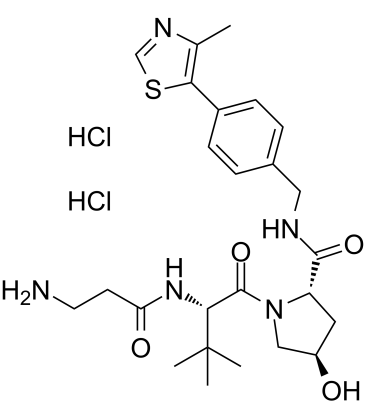(S,R,S)-AHPC-C2-NH2 dihydrochloride
Modify Date: 2025-09-15 12:17:18

(S,R,S)-AHPC-C2-NH2 dihydrochloride structure
|
Common Name | (S,R,S)-AHPC-C2-NH2 dihydrochloride | ||
|---|---|---|---|---|
| CAS Number | 2341796-73-2 | Molecular Weight | 574.56 | |
| Density | N/A | Boiling Point | N/A | |
| Molecular Formula | C25H37Cl2N5O4S | Melting Point | N/A | |
| MSDS | N/A | Flash Point | N/A | |
Use of (S,R,S)-AHPC-C2-NH2 dihydrochloride(S,R,S)-AHPC-C2-NH2 dihydrochloride incorporates a VHL ligand for the E3 ubiquitin ligase, and a PROTAC linker. (S,R,S)-AHPC-OH can be used in the synthesis of a series of PROTACs[1]. |
| Name | (S,R,S)-AHPC-C2-NH2 dihydrochloride |
|---|
| Description | (S,R,S)-AHPC-C2-NH2 dihydrochloride incorporates a VHL ligand for the E3 ubiquitin ligase, and a PROTAC linker. (S,R,S)-AHPC-OH can be used in the synthesis of a series of PROTACs[1]. |
|---|---|
| Related Catalog | |
| Target |
VHL |
| In Vitro | PROTACs contain two different ligands connected by a linker; one is a ligand for an E3 ubiquitin ligase and the other is for the target protein. PROTACs exploit the intracellular ubiquitin-proteasome system to selectively degrade target proteins. |
| References |
| Molecular Formula | C25H37Cl2N5O4S |
|---|---|
| Molecular Weight | 574.56 |
| Hazard Codes | Xi |
|---|